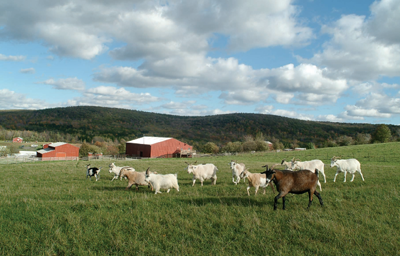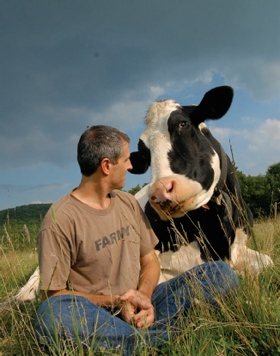With a moo-moo here and a moo-moo there, a nonprofit offers refuge to abused and neglected farm animals
With a moo-moo here and a moo-moo there, a nonprofit offers refuge to abused and neglected farm animals
On a blue-sky afternoon in late August, a livestock truck rolls down a dirt road toward a farm outside Watkins Glen, New York, passing through a gate and climbing the gentle slope toward a large barn. As workers prepare to welcome its lone passenger, they catch a hint of movement inside the trailer as a single, curious bovine eye peeks through a slit in the metal. The trailer doors swing open, and Farm Sanctuary's newest resident is coaxed down a ramp and into his permanent home.
His name is Jay, and he's one lucky bull. On his way to slaughter several weeks earlier, Jay was jammed into a livestock carrier that overturned in a fiery crash on Indiana's I-94. Many of the three dozen animals were burned alive, others were gravely injured, and the few survivors who could walk were rounded up and sent to the slaughterhouse. But Jay, a two-year-old Holstein, ran for his life.
He was found several miles from the crash site, and a local animal welfare group appealed for help from Farm Sanctuary, a nonprofit devoted to caring for abused and neglected livestock. Jay was transported directly to the Cornell Vet college, where he spent two weeks being treated for severe burns and other injuries. Angry streaks of red still mar his flesh as he tentatively sniffs the barn floor, a camera crew from the Elmira TV news recording the occasion. Something of a reverential silence settles over the humid barn as a dozen Farm Sanctuary workers and volunteers watch the giant animal take in his new surroundings, a soft landing after so much pain and trauma.
At the sanctuary, Jay joins a menagerie of creatures who have survived their own close calls—from a piglet who fell off a transport truck to a starving sow and her babies rescued from a flooded Iowa levee. On a tour, shelter director Susie Coston points out a trio of Moulard ducks. "They fell off a truck in New York City," she says, "and a bunch of kids started stomping them." Luckily, a Good Samaritan intervened, and they found their way to the farm. Then there's a goat named Gloria, who spent eight years tied up at a racetrack. And a flock of turkeys dropped off at the farm as chicks, just hours after having their beaks and toes lopped off per standard industry practice. "At Farm Sanctuary," says Gene Baur, MS '96, the organization's president, "the animals are our friends, not our food."

The group was the first of its kind when Baur co-founded it in 1986 after rescuing Hilda, a sheep found in a pile of dead "downers" at a stockyard. The nonprofit moved to its Watkins Glen home, a family farm that had fallen into disrepair, in 1990; it also maintains a shelter in Orland, California. In addition to housing an array of cattle, pigs, chickens, ducks, geese, turkeys, sheep, and goats on its grounds, Farm Sanctuary places rescued animals in approved homes around the country, with adopters (all vegetarians or vegans) who pledge to keep them as companions rather than commodities. "We work to change how society views and treats farm animals," Baur says. "The sanctuaries are places of transformation, where animals' lives have been changed, and where people can get to know these individuals and be touched by them."
Another of Farm Sanctuary's missions is advocacy, working to change factory farming practices, such as the use of gestation crates for breeding sows or the forced feeding of foie gras ducks. It also aims to educate the public about the livestock industry—encouraging people to, as the saying goes, "meet their meat." "People eat meat, milk, and eggs without really thinking about it," Baur says. "We want them to realize that they have choices. I never made a conscious decision to eat animals, and as I stepped back and started learning more and thinking about it, I didn't feel good about killing them—and I don't think most people feel good about it either. The slaughterhouse is an inherently violent place."

Growing up in the Hollywood Hills, Baur not only ate meat as a child, he appeared as an extra in commercials for fast-food chains like McDonald's and KFC. Although he went vegetarian in high school, he resumed eating meat during his days as a sociology major at California State University, Northridge. After graduation, he did advocacy work with groups like Greenpeace and became increasingly concerned about the toll of factory farming—and the American diet—on animal welfare, human health, and the environment. "It's destroying our planet, it's destroying our health, and it's causing animals to suffer in a way that we don't want to look at," he says. "The way we eat in this country is killing us. Heart disease and cancer are the top causes of death, and the risk of both can be greatly reduced by eating more plants and fewer animals. All the evidence points to the fact that the best way to feed the world's population is by growing plants and eating them directly, instead of wasting energy by feeding them to animals. At the end of the day, the system is cruel, wasteful, inefficient, and unnecessary."
Baur became a vegan and raised much of the money to found Farm Sanctuary by selling veggie dogs at Grateful Dead concerts. Then, in the interest of learning more about the system he wanted to change, he earned a master's in agricultural economics from Cornell. (During his time on the Hill, he was known as Gene Bauston, a name he adopted during a former marriage.) "I remember being in an animal science class where the professor warned us, probably for a couple of hours, about the dangers of 'these animal rights people' coming in," he recalls with a laugh. "And here I was, an animal rights vegan, just being very quiet and taking it all in."
The relationship between the sanctuary and the University has since deepened, as the Vet college has become a primary source of medical care for the animals at the Watkins Glen shelter. Cornell vets make regular visits to treat patients and train sanctuary staff, with the more serious cases—like Jay—transported to campus. The shelter also offers opportunities to educate vet students and residents. "We have the oldest farm animals in the country," Coston notes, so they face geriatric issues unheard of in industry, where they're slaughtered when they're weeks or months old. "This is a challenge, because if you look in the textbooks, there is nothing about a broiler chicken or a layer hen that is six years old, because all the books are based in production medicine," says Ricardo De Matos, a lecturer in avian medicine and surgery. "Some of the conditions we see, there are no reports of them. So there's a lot we learn as we work with these animals."
About a year ago, Baur moved from his longtime home in Watkins Glen to College Park, Maryland, to facilitate his federal policy work and make it easier to travel the country for speaking engagements. His position on the cultural spectrum has shifted as well: although his beliefs were once seen as radical, societal changes have nudged him toward the center. These days, most major supermarkets sell veggie burgers and tofu dogs, and vegan chefs appear on the Food Network. "We're in the midst of a burgeoning food movement," Baur says. "Consumers are realizing that how they eat has profound consequences. Vegetarians and vegans are much more common. The market for soymilk and other plant-based alternatives to animal foods is growing every year. So we're making some great progress. There's starting to be a recognition that when you weigh all the costs, cheap food is not that cheap after all."
— Beth Saulnier


